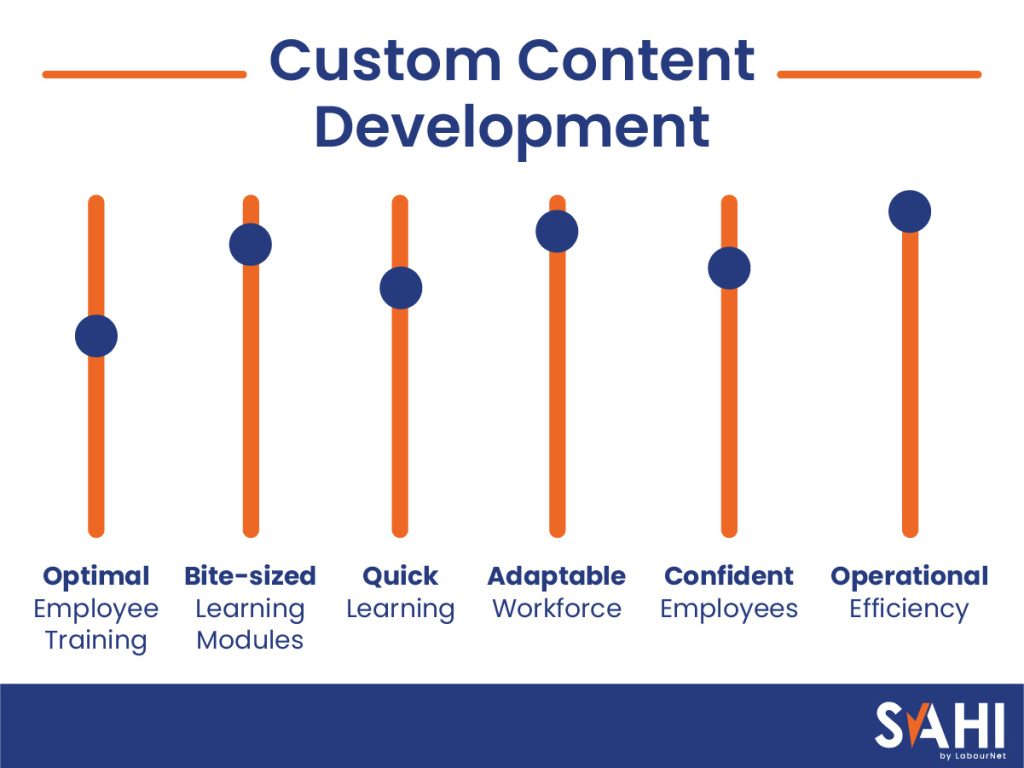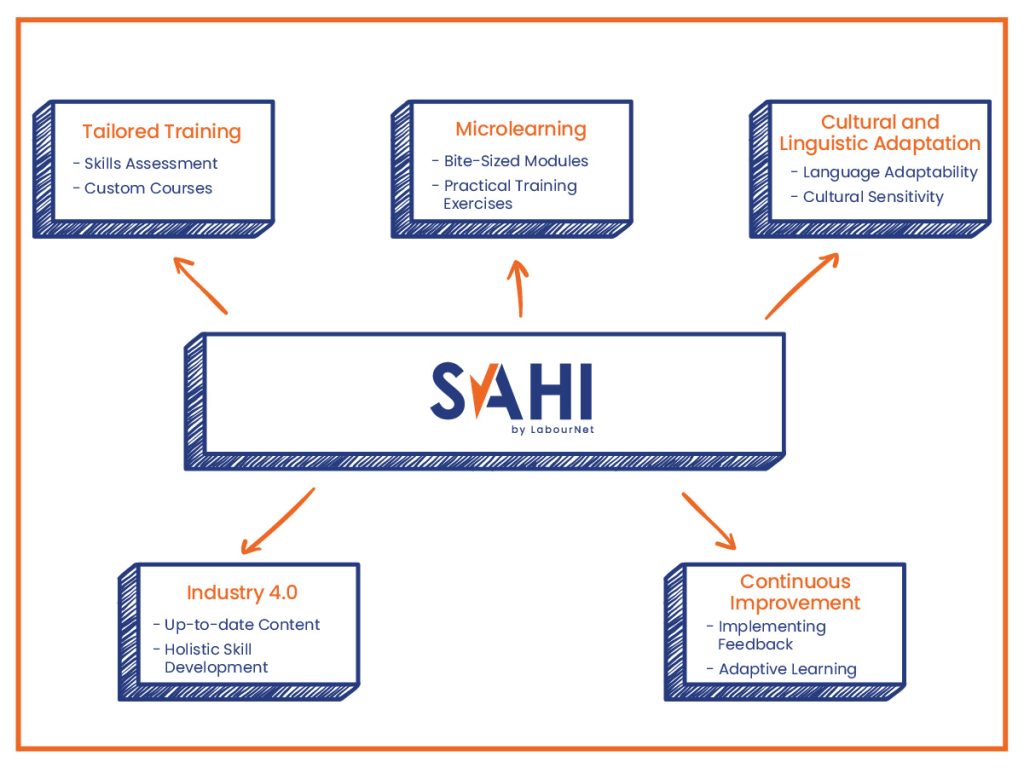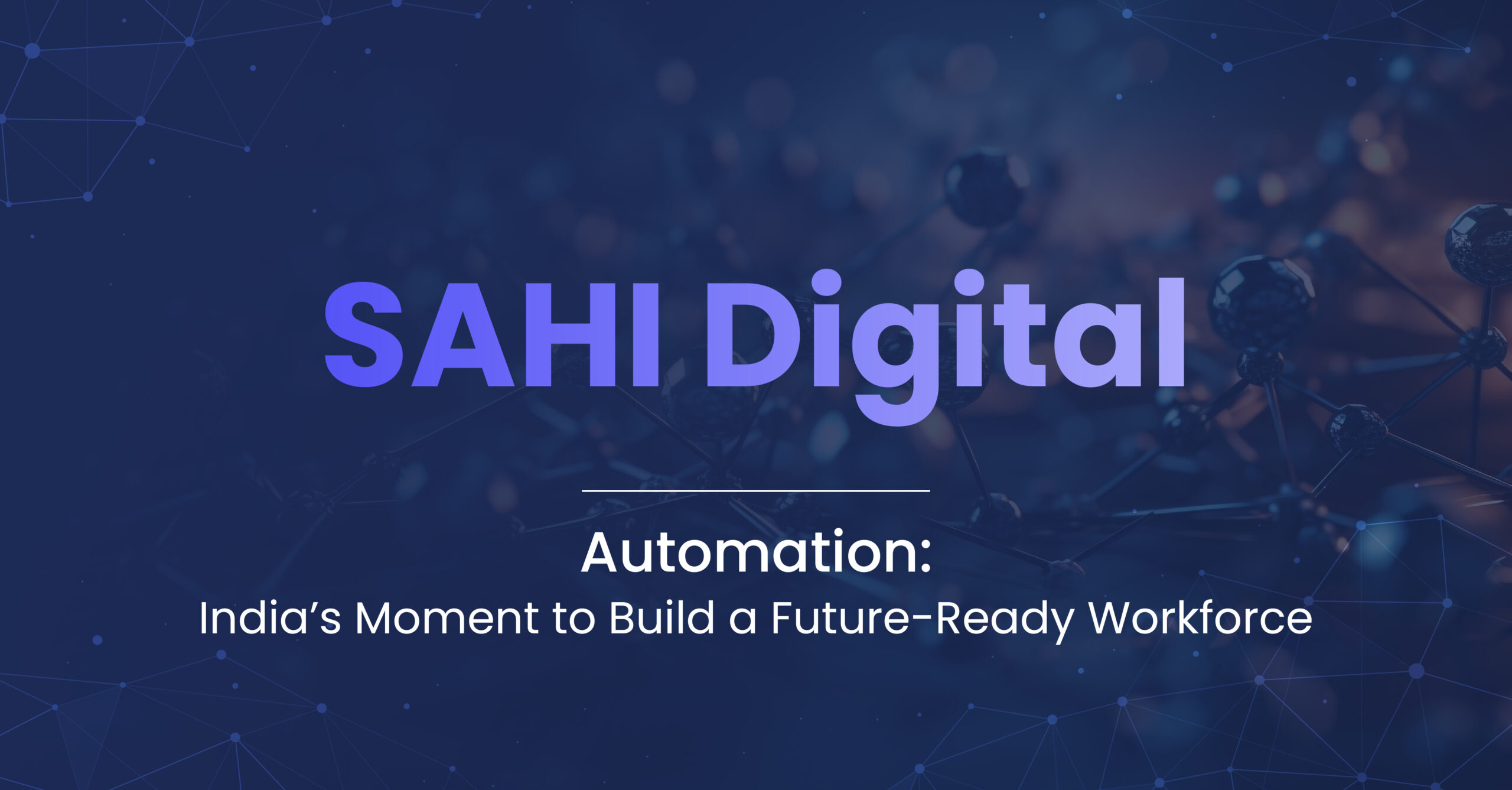In the rapidly evolving landscape of the manufacturing sector, the quest for efficiency is relentless. For Learning & Development (L&D) Heads, a pivotal part of this quest lies in skill development through employee training and development.
Yet, traditional training development often falls short, failing to address the unique challenges and skill requirements of a blue-collar workforce.
The gap between generic training courses for employees and the nuanced realities of the manufacturing floor can result in a disconnect. Moreover, training programs can feel more like an obligatory chore rather than a lever for growth.
Enter the need for a specialised blue-collar training program. A program that transcends conventional boundaries and embraces microlearning and skills assessment tailored for skilled labour training.
As the manufacturing sector contends with complex machinery and sophisticated processes, the demand for a workforce equipped with industry-specific blue-collar skills is at an all-time high.
Custom content development emerges as a premier solution, promising to bridge the divide with training that’s as precise as the tasks at hand.
In the following sections, we delve deep into how L&D strategies can be revolutionised, turning every training opportunity into a cog in the wheel of manufacturing excellence.
What is the Current State of the Manufacturing Landscape?
The manufacturing sector, a cornerstone of the global economy, comprises diverse industries, each with unique challenges and workforce needs. From the precision-driven world of automobile manufacturing to the robust dynamics of the heavy machinery sector, the need for skill development is paramount.
This spectrum also includes the intricacies of the electronics industry and the foundational strength of the steel industry. In each of these sectors, factory and plant workers play a pivotal role, their skills and adaptability forming the backbone of production efficiency and innovation.
For instance, in automobile manufacturing factory workers need skills that blend mechanical acumen with an understanding of emerging automotive technologies. Meanwhile, the steel industry demands a workforce adept in understanding metallurgical processes. Plant workers often encounter high-temperature environments and material handling complexities.
The Essence of Skills Training
Blue-collar skills range from technical prowess to operational safety. Employee training and development must, therefore, be meticulously aligned not just with industry standards but also with the nuanced demands of each specific role.
For instance, a quality control technician in the electronics industry requires a different skill set than a machine operator in the steel industry.
Moreover, skills assessment is vital in identifying these diverse needs, forming the basis for a tailored blue-collar training program. Such programs should not only focus on hard skills but also on enhancing cognitive and soft skills.
This dual focus is essential for enabling workers to adapt to new technologies and methodologies prevalent in their specific sectors. As a sector continues to evolve with advanced technologies, the call for innovative training development becomes more pronounced.
Incorporating microlearning segments into these training programs supports an agile learning process. This will be crucial for meeting the specific blue-collar training needs of today’s diverse manufacturing workforce.
Each microlearning module can be designed to address the unique challenges faced by workers in different manufacturing domains, from automotive assembly lines to electronics manufacturing plants.
Where Does Custom Content Development Fit In?
Custom content development steps in as a strategic ally, ensuring that training courses for employees are not just a one-size-fits-all solution. Rather they are a tailored fit for the intricate array of skills required in modern manufacturing.
This approach promises to elevate the competency of blue-collar workers. It aims to transform them into a skilled labour force to navigate the complexities of the manufacturing sector with confidence and proficiency.
In this environment, it becomes clear that generic training materials are no longer sufficient. The manufacturing sector demands robust, custom-tailored solutions that address the unique challenges of the environment.
A requirement that SAHI’s innovative approaches to skill development are equipped to fulfil.
Limitations of A One-Size-Fits-All Content
The concept of one-size-fits-all is a misfit in the context of employee training and development, especially within the manufacturing sector. Generic training materials often overlook the nuanced demands of blue-collar training, where specific machinery, processes, and safety protocols are in play.
These off-the-rack solutions fail to resonate with the on-the-ground realities that skilled labour training must address.
Moreover, the absence of industry-tailored content in such training development programs can lead to a disconnect. We have often seen a lack of relevance between the skill development imparted and the actual competencies required on the factory floor.
This gap is where the essence of microlearning and skills assessment becomes evident. Microlearning, with its targeted approach, can tackle specific learning objectives effectively, a strategy that generic materials cannot replicate.
A blue-collar training program needs to be rooted in the real-world scenarios of the manufacturing environment. What you need is to incorporate a custom approach to training courses for employees.
As a result, you can ensure that the workforce is trained and adept to apply their blue-collar skills effectively.
The one-size-fits-all approach also typically fails to adapt to the cultural and language diversity within the workforce, which can hinder engagement and retention of the material. This calls for a more personalised strategy that aligns with the workers’ context, thereby enhancing their learning experience and operational efficiency on the job.
The Power of Customization in Skilled Labor Training

Custom content development stands as a cornerstone in the pursuit of optimal employee training and development within the manufacturing sector. This bespoke approach to training harnesses the potential to address the distinctive operational challenges and skill gaps that are prevalent on the manufacturing floor.
By creating tailored training courses for employees, particularly for the blue-collar workforce, L&D heads can ensure that skill development transcends the conventional methodologies that often miss the mark.
The concept of microlearning is central to custom content development, providing bite-sized, manageable learning units that are easier to digest and retain. This method proves especially effective in blue-collar training programs where time away from the production line is costly.
Microlearning modules can be seamlessly integrated into the workflow, enabling blue-collar workers to develop blue-collar skills without significant downtime.
Furthermore, a refined skills assessment process is integral to custom content development, pinpointing the exact areas where training is needed. This targeted strategy ensures that training development is not just a box-ticking exercise but a fundamental component of a company’s strategy to foster a capable and adaptable workforce.
The result is a more confident, efficient, and proficient set of employees, equipped with skill sets that precisely match the contemporary demands of the manufacturing industry.
By incorporating custom content development into their training strategies, manufacturers can ensure that their workforce is not left behind in the rapidly changing industrial environment. This focused approach to blue-collar training programs ensures that the skills imparted are directly applicable to the tasks at hand.
And how does this help? It results in a marked improvement in operational efficiency and a tangible return on investment in employee development.
Key Considerations for Developing Custom Content
Understanding the Workforce: Language and Culture in Content Development
When embarking on the journey of custom content development for blue-collar training, it’s essential to start by understanding the workforce’s linguistic and cultural landscape. This understanding informs the creation of training development materials that are not just informative but also relatable.
- Language Clarity and Accessibility: The language used in employee training and development programs must be clear, jargon-free, and easily accessible. It should bridge any gaps in understanding, enabling workers to grasp complex concepts without linguistic barriers.
- Cultural Resonance and Relevance: Cultural nuances influence how information is perceived and processed. Training courses for employees must be culturally sensitive, resonating with their lived experiences and aligning with their values to foster a deeper connection with the content.
Aligning Technical Competencies with Industry Standards
In the realm of skill development, technical accuracy and current industry standards are non-negotiable. Custom content must mirror the latest trends and technologies in the manufacturing sector to ensure relevancy and utility.
- Up-to-Date Technical Information: The content must reflect the latest advancements and methodologies in manufacturing. This ensures that the blue-collar skills being taught are not obsolete but are preparing the workforce for the future.
- Skills Assessment and Gap Analysis: A thorough skills assessment should precede content development to identify specific skill gaps. This analysis ensures that the training addresses the actual needs of the workforce, leading to a more efficient and competent team.
Ensuring Practical Applicability through Microlearning
The end goal of any training program is to equip the workforce with applicable skills. Microlearning techniques can enhance the practical applicability of training, breaking down complex information into manageable, actionable lessons.
- Task-Oriented Learning Modules: Developing short, focused modules centred around specific tasks or functions allows workers to apply what they learn immediately, reinforcing the training and improving retention.
- Hands-On Training Simulations: Simulations and practical exercises transform theoretical knowledge into tangible skills. Custom content should include scenario-based learning that mimics on-the-job situations, providing a safe environment to practise and master new skills.
Measuring Effectiveness and Continual Improvement
A robust training development program incorporates mechanisms for feedback and continual improvement, ensuring the content remains effective and relevant over time.
- Feedback Loops and Content Iteration: Gathering feedback from participants and trainers provides insights into the effectiveness of the training. This feedback should be used to iterate and improve the content continuously.
- Ongoing Skills Assessment and Refinement: Continuous skills assessment post-training ensures that the learning objectives are being met and identifies areas for further development. This cyclical approach guarantees that the workforce’s skills remain sharp and aligned with industry demands.
As you can see, custom content development for the manufacturing sector is a strategic approach that addresses the unique training needs of the blue-collar workforce. Learning & Development heads can create a training program that truly transforms their workforce by –
- Considering language and cultural elements
- Aligning content with technical competencies
- Focusing on practical application through microlearning
- Setting up structures for ongoing assessment and refinement
This tailored approach not only enhances the efficiency of the workforce but also contributes to the overall growth and competitiveness of the manufacturing sector.
SAHI’s Approach to Skilled Labor Training

In the realm of manufacturing, the efficiency and competency of the workforce are pivotal. SAHI, with its nuanced understanding of the sector’s intricacies, takes a methodical approach to skill development and blue-collar training.
This section will explore how SAHI’s strategies align with the distinctive needs of the manufacturing workforce, shaped by practicality and an in-depth understanding of the field’s requirements.
Tailored Training to Bridge the Skills Gap
SAHI recognizes that effective employee training and development hinge on addressing the precise needs of workers. By conducting comprehensive skills assessments, SAHI pinpoints the existing skills gap, facilitating a focused approach to training development.
- Skills Assessment – The Starting Point: A thorough skills assessment forms the bedrock of SAHI’s strategy. This process helps in customising content to fill specific skill shortages, ensuring that the training is not generic but is instead highly targeted and relevant.
- Custom Courses for Employee: Upskilling SAHI curates custom training courses for employees, each meticulously crafted to upgrade the workforce’s skills in line with contemporary manufacturing processes and technologies.
Microlearning for Maximum Impact
In its quest for effective skilled labour training, SAHI leverages microlearning—a technique well-suited to the dynamic and often time-constrained environment of manufacturing.
- Bite-Sized Learning for Better Retention: Microlearning modules, focused on specific competencies, facilitate quick learning and better retention. These bite-sized pieces of content are designed to fit into the busy schedules of blue-collar workers, making learning more manageable and less disruptive to their workflow.
- Practical Training Simulations: Beyond theoretical knowledge, SAHI incorporates practical training simulations into its microlearning modules. As a result, the blue-collar skills imparted are immediately applicable on the factory floor.
Cultural and Linguistic Adaptation in Content
SAHI’s content development transcends linguistic barriers and incorporates cultural context. Hence, it reflects an understanding that the workforce is diverse and training needs to be inclusive.
- Language Adaptability in Training Modules: Training modules are designed to be linguistically accessible, ensuring that language does not become a hindrance to learning but rather facilitates it.
- Cultural Sensitivity in Training Scenarios: SAHI ensures that the training materials are culturally pertinent, resonating with the workforce’s experiences and ensuring higher engagement rates.
Continuous Improvement through Feedback
Feedback is a cornerstone of SAHI’s approach to training development, used to refine and enhance training modules continuously.
- Implementing Constructive Feedback: SAHI values the feedback from both trainees and trainers, using it to make the training content more effective and responsive to the manufacturing sector’s ever-evolving needs.
- Adaptive Learning Pathways: The feedback mechanisms also help in tailoring the learning pathways for individual workers, adapting the training to suit various learning paces and styles.
Preparing for Industry 4.0 with SAHI
As the manufacturing sector evolves with Industry 4.0, SAHI’s training programs also evolve to keep the workforce abreast with the latest technological advancements.
- Up-to-Date Content for a Future-Ready Workforce: SAHI’s training development is proactive, incorporating the latest trends and innovations, which ensures that the workforce is not only current but also future-ready.
- A Holistic Approach to Skill Development: SAHI’s holistic approach goes beyond mere training. It aims to instil a culture of continuous learning and improvement, essential for the modern manufacturing landscape.
The unique approach to blue-collar training is characterised by its custom content that is specifically developed to meet the unique needs of the manufacturing workforce. This approach is meticulous and considers various factors, including language, culture, practical applicability, and the necessity for continuous improvement.
It’s evident that SAHI’s methodology is designed to enhance the efficiency of the manufacturing workforce, preparing them for the current and future demands of the industry.
Unleashing Workforce Potential Through Custom Training Solutions
In the intricate tapestry of the manufacturing sector, the advancement of the workforce stands paramount. Custom content development, meticulously designed to address the real-time challenges and skill demands of the industry, has proven to be a game-changer.
It is the linchpin in transforming skill development, employee training, and development into a potent tool for empowering the blue-collar workforce.
Customized training solutions cater to the nuanced requirements of manufacturing, enabling employees to master blue-collar skills through tailored blue-collar training programs. These bespoke training courses for employees resonate with their daily tasks and challenges, fostering a deeper understanding and practical applicability of new skills.
Through strategies like microlearning and a focus on skills assessment, the learning experience is personalised, digestible, and aligned with the workers’ cultural contexts. Such an approach enhances learning engagement and retention while ensuring the training development process continually adapts to the evolving landscape of the manufacturing floor.
The result is a more confident, competent workforce, ready to navigate the complexities of modern manufacturing with dexterity. Custom content development doesn’t just educate – it revolutionises how the manufacturing sector approaches its most valuable asset—its people.
This forward-thinking strategy primes the workforce for efficiency and excellence, meeting today’s demands and tomorrow’s challenges with unwavering capability.
Elevate Your Manufacturing Workforce with Tailored Training Solutions
As we navigate the complexities of skill development in the manufacturing realm, the significance of a tailored approach to employee training and development cannot be overstated.
It’s time to reflect on your current strategies and decide whether they are truly addressing the specific needs of your skilled labour force.
If your answer is no, consider the transformative impact that custom content can have on your training development efforts. By integrating microlearning techniques, focusing on precise skills assessment, and designing blue-collar training programs that speak directly to your workforce, you can forge a path to unparalleled efficiency and expertise.
Challenge the status quo with training courses for employees that resonate, engage, and empower. Take the first step towards a future where every training module propels your workforce forward.
Let’s redefine what it means to develop blue-collar skills in today’s manufacturing landscape.


